Vectorspace (talk | contribs) No edit summary |
Vectorspace (talk | contribs) |
||
| Line 31: | Line 31: | ||
=== Motor Vehicle Use Maps (MVUMs) === | === Motor Vehicle Use Maps (MVUMs) === | ||
[[file:USFS-legend-1.png | right | 300px]]The key point of the USFS's Travel Management Rule is that motor vehicle use on National Forest System Lands is restricted to designated routes which are shown on the Motor Vehicle Use Maps (MVUMs). Only routes on the MVUMs should be entered into Waze. Of those roads and trails, only those accessible by passengers or 4x4 vehicles should be mapped. USFS shows trails specifically for motorcycle use only. These should not be added to the Waze map. | [[file:USFS-legend-1.png | right | 300px]]The key point of the USFS's Travel Management Rule is that motor vehicle use on National Forest System Lands is restricted to designated routes which are shown on the Motor Vehicle Use Maps (MVUMs). Only routes on the MVUMs should be entered into Waze as driveable roads. Others may be marked as Walking Trails. Of those roads and trails, only those accessible by passengers or 4x4 vehicles should be mapped. USFS shows trails specifically for motorcycle use only. These should not be added to the Waze map. | ||
MVUMs can be found at the links at the end of this page via PDF maps and also an online GIS system that does not list maintenance level. | MVUMs can be found at the links at the end of this page via PDF maps and also an online GIS system that does not list maintenance level. | ||
Revision as of 21:17, 13 January 2015
| This new page is currently undergoing modifications. The information presented should be considered a draft, not yet ready for use. Content is being prepared by one or more users. Do not make any changes before you send a private message to this user. Please use the talk page for thoughts and ideas on setting up this content. |
| Last update 13Jan15 |
Background
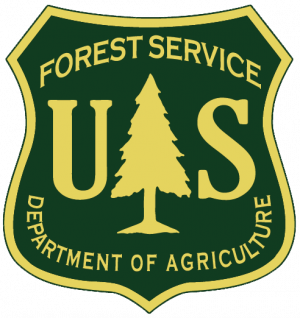
Among many of the functions of the United States Forest Service (USFS) is the development and maintenance of Forest System roads that are relied upon by USFS and the public. The USFS uses these to maintain its forests, aid in fighting forest fires, allow public use, and other functions. General information for Waze editors begins at USFS is their Travel Management section. See the Editing Resources section below for more specific map resources.
Some of these roads can be critical to local populations not just for recreation, but for regular travel. Such use is likely more common in rural and western states than it is for urban or eastern states. At times, some well-maintained dirt roads may even be considered to the local population as equivalent to streets or primary streets.
The USFS specifically issues Motor Vehicle Use Maps (MVUM) that identify specifically where USFS allows use of their roads by public motor vehicles. Some of these roads are paved and well maintained, others are dirt but used like streets, while others are dirt roads that are not well maintained and will only accommodate 4x4 wheel vehicles. Some roads are only listed for motorcycle use. Note that these maps show only show roads that the USFS wants used by the public. There are other USFS roads that are closed or otherwise not authorized for public use.
Waze and Forest Service Roads
Creating accurate and properly represented USFS roads in Waze will:
- benefit large numbers of tourists and recreational users of USFS roads,
- allow those lost in some areas to navigate to regular roadways,
- allow local populations appropriate use of USFS roads,
- allow Waze editors to functionally classify roads by marking them with the appropriate Waze road type (street, 4x4, etc.),
- allow some roads to be marked as private to the USFS,
- allow identification of useful Waze Places on USFS land,
- allow time-based restrictions on some roads that are closed in winter.
Functional Classification
There are two primary sources of information that Waze editors may obtain from the USFS:
- Motor Vehicle Use Maps (MVUMs), and
- Raw GIS data.
This section suggests a mapping of USFS roads to Waze roads depending on which source you use.
Motor Vehicle Use Maps (MVUMs)
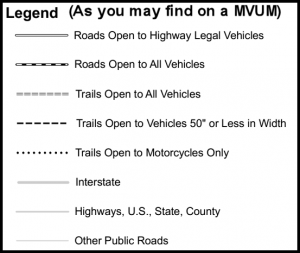
The key point of the USFS's Travel Management Rule is that motor vehicle use on National Forest System Lands is restricted to designated routes which are shown on the Motor Vehicle Use Maps (MVUMs). Only routes on the MVUMs should be entered into Waze as driveable roads. Others may be marked as Walking Trails. Of those roads and trails, only those accessible by passengers or 4x4 vehicles should be mapped. USFS shows trails specifically for motorcycle use only. These should not be added to the Waze map.
MVUMs can be found at the links at the end of this page via PDF maps and also an online GIS system that does not list maintenance level.
If you are able to obtain a physical MVUM or download a PDF online, you will find that it has exacting detail on road types and names you may wish to edit in Waze. The following images show an example front cover of a folded map and the internal content that can be seen on both sides of an unfolded map.
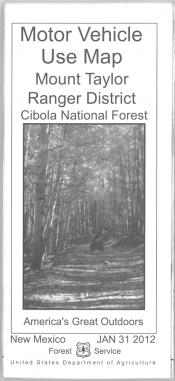
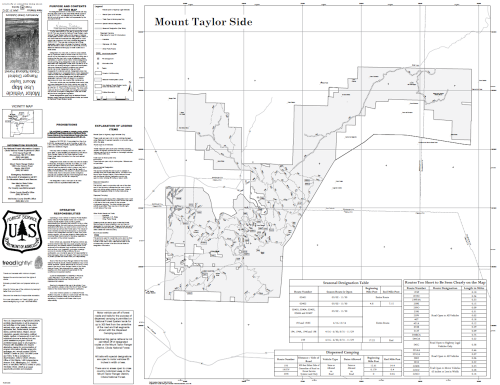
Maintenance Levels & GIS Data
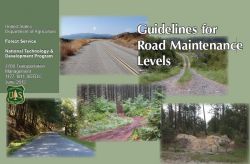
The US Forest Service classifies maintenance of National Forest System roads by five levels: 1, 2, 3, 4, and 5. Maintenance level 1 roads are closed to motor vehicle use. Maintenance level 2 roads are maintained for high-clearance (4x4, off-road) vehicles. Maintenance level 3, 4, and 5 roads are maintained for passage by standard passenger cars during the normal season of use.
Picking the best road types in Waze for the Forest Service roads is suggested in the following table. Levels 5, 4, and 3 are navigable by regular automobiles, but may not always be appropriate to be streets within the Waze map.
You will only find these Maintenance Levels in source GIS data from the USFS. This information is utilized by USFS to help create the MVUMs.
Maintenance Level Road Images
The following images, extracted from the USFS maintenance document above, provide examples from USFS for these road types. They may help illustrate differences between levels that will help you while editing. If you observe a USFS road in person, these images may help you determine the maintenance level.
| Maintenance Level |
Example A | Example B |
| Level 5 = Minor Highway Primary Street Street |

|

|
| Level 4 = Street |

|

|
| Level 3 = Street |

|

|
| Level 2 = Dirt Road / 4x4 Trail |

|

|
| Level 1 = Walking Trail or Do Not Map |

|

|
Editor Discretion
Images shown above cannot cover all scenarios for mapping maintenance level to Waze road type. These roads may undergo variation in quality over seasons as well depending on the climate (rain/snow). Particularly, some roads in Level 3 may have attributes that are closer to Dirt Road / 4x4 Trail than street. Editors with local experience or potential Street View images may help in this determination.
USFS to Waze Classification Mapping
While editing USFS roads, you'll either have (1) MVUMs or (2) more detailed GIS data or related maintenance level observations. This section provides mapping for both sources of information, but the Waze editor should always consult the MVUMs because only roads on the MVUMs should be shown as available for use. Others should be Private roads or not mapped.
Motor Vehicle Use Maps (MVUMs)
The key point of the USFS's Travel Management Rule is that motor vehicle use on National Forest System Lands is restricted to designated routes which are shown on the Motor Vehicle Use Maps (MVUMs). All routes not on the MVUMs should be marked as private.

| MVUM Road Legend |
Suggested Waze Road Treatment |
| Roads open to Highway Legal Vehicles | Street, Primary Street, or Minor Highway as appropriate. |
| Roads Open to All Vehicles | Street |
| Trails Open to All Vehicles | Do not map. |
| Trails Open to Vehicles 50" or Less in Width | Do not map. |
| Trails Open to Motorcycles Only | Do not map. |
| Interstate* | Freeway |
| Highways, US, State, County* | Map as appropriate to road type. |
| Other Public Roads* | Map as appropriate to road type. |
*Note that these last three non-USFS roads were included in their legend because such roads may traverse USFS lands. Treat these roads as you would regular public roads.
Mixed Type or Mapping of USFS Roads
Note that a a particular Forest Service Road may be only shown on the MVUM for a part of its distance. In such cases mark part of the road per the above table and the remaining portion not on the MVUM as type Private. If a road has mixed types along its length, map them all appropriately in Waze.
Maintenance Levels & GIS Data
In cases where the Maintenance Level is known from GIS data or inferred from the images in this article, use this table for guidance. Note that you should also refer to the MVUMs to make sure the road is displayed.
| USFS Maintenance Level |
Short Name |
Description | Suggested Waze Road Treatment |
| 5 | Highway | High traffic and speeds, usually paved, double lane, arterial or collector, typically connected to state and county roads. There are few of these roads in the inventory. | If shown on MVUM, select Minor Highway, Primary Street,or Street. If not on MVUM, Private |
| 4 | Paved | Moderate speeds, often dual lane, may be paved but usually aggregate surface, usually collectors, may connect to state and county roads | If shown on MVUM, Street. If not on MVUM, Private. |
| 3 | Passenger Vehicle |
Low speeds, single lane, local or collectors, may have potholes or washboarding | If shown on MVUM, Street. If not on MVUM, Private. |
| 2 | Unpaved 4x4 |
Unpaved local roads, may not be passable in inclement weather, high-clearance vehicles needed, not suitable for passenger cars. | If shown on MVUM, Dirt Road/4x4 Trail. If not on MVUM, Private |
| 1 | Closed | Vehicular traffic is prohibited, might be used as a motorized trail for use by motorcycles, etc. | Private for existing roads. Do not map new roads. |
Level 5 & Level 3
Note that Levels 5 and 3 may have ambiguity for Waze Editors. This is because there may be large variability in local interpretation and actual maintenance due to weather and other effect which would determine the road type that is important to Wazers. In rural or some western states, some the very same type of USFS road may be best marked as a Minor Highway or Primary Street whereas in urban areas, they may be interpreted best as streets. Local editors or any available street view should be used to help decide the best mapping. Here are some suggestions.
USFS Level 5
- Pick the lowest level of road type that is reasonable for the surrounding area.
- Pick "Primary Street" or "Minor Highway" when the local function of this road is equivalent to those Waze road types.
USFS Level 3
- Preference is to always mark these roads as Waze type "Street."
- In rare cases pick "Dirt Road / 4x4 Trail" if you verify the road is in poor condition.
Road Naming Conventions
There is wide variability in existing road names for roads on USFS land. Formal USFS road names you might see include "Forest Rd XXX," "Fire Service XXX," "F S XXX," "Nat For Dev Rd," "Forest Rte XXX," and "Forest Svc Rd." Those that have significant public or popular use may have local road names with road signs. State highways and county roads may traverse USFS land, and will be named under conventions for those types of roads.
USFS Naming Conventions
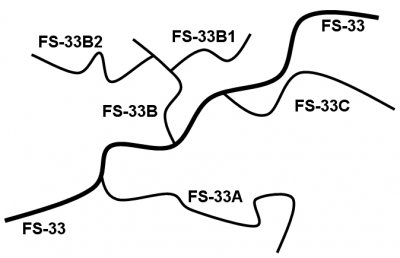
These naming conventions may help you understand the online GIS maps and PDF maps available from USFS.
Naming is typically recursive based upon road stubs. For instance, if a main road has name "33" then stubs from that road may be, 33A, 33B, 33B1, 33B2, 33C, etc. using alternating designations (letters, numbers). The third level of “33B1” is road 33, stub B, secondary stub 1. The exact choice is of this format is picked by different road engineers. See the image to the right for a pictorial of this concept.
Waze Naming Conventions
The following convention is suggested for naming roads on USFS land:
- Public highways and county roads should be named under conventions for the state or region. Do not use a USFS road number/name for these roads.
- USFS roads on the MVUMs with popular names as shown on posted road signs should be named per the road signage. Note that the MVUMs do not usually show these popular names. Use street-view or drive by the location to verify before changing names from a popular name to a USFS road number/name.
- USFS roads on the MVUMs that are not named or with an alternative naming convention should be named "FS-XXXX" where XXXX is the USFS road name on the MVUM. For example, main FS-333 road might have stub roads FS-333A through FS-333E.
- Fire Service Roads, roads designated for Forest Fire services, shall also use the "FS-XXX" designation
USFS Places for Waze
Resources at USFS websites or USFS maps may be useful at correctly naming and adding USFS Places to the Waze Map. USFS MUVMs contain names of campgrounds and other items of interest. The following convention is suggested for some Places types. Please refer to the Places Wiki page for more guidance on how now to create an Area or Point "Place" and categories to choose.
Editing Resources
The USFS Travel Management & Off-Highway Vehicle (OHV) Program website contains a number of resources that will be useful for Waze editors. Specific links follow.
Interactive Travel Map
The Interactive Travel Map is a GIS system for USFS land and roads. It shows the National Forest System roads, National Forest System trails, and areas on National Forest System lands that are designated for motor vehicle use. The map is searchable by vehicle class, time of year, route number, and travel mode. You can zoom into an area on a national forest or grassland, see the roads and trails in that area, and find out which ones are open to motor vehicles, and when. You can see rivers, lakes, mountain peaks, campgrounds, and topographic lines. Land ownership is shown by color. You can also print a map of the area you wish to visit.
This site may not have the most current data from every part of the United States, so make sure to check other resources. Data may not be available for all forests.
USFS Motor Vehicle Use Maps (MVUM)
Motor Vehicle Use Maps (MVUM) identify specifically where USFS allows use of their roads by public motor vehicles. They are available for a small fee in hard copy online, are free at USFS offices, or can be found online in PDF format.
A listing of forests that maintain MVUMs is available as a great resource for Waze editors. From this link you must select the appropriate forest listed by state. On those pages will be listed the MVUMs that are available.
USFS GIS Data
We have arranged to get access to current GIS data sets from the various forests. Details on this data are being worked to provide easier access. Until we have details worked out, PM user vectorspace to obtain more information.
Similar Road Systems
References
(1) Discussions with USFS GIS staff.
(2) USFS website.